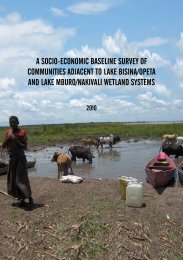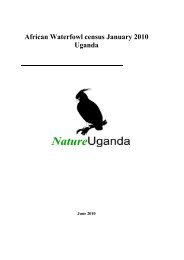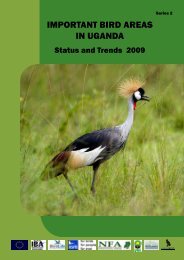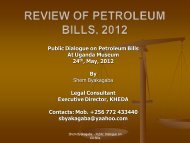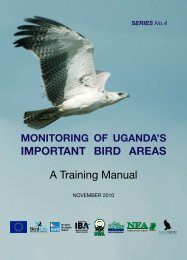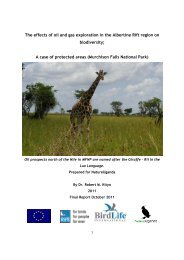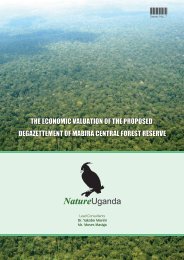A Ecological Baseline Surveys Of: - Lake Bisina - Nature Uganda
A Ecological Baseline Surveys Of: - Lake Bisina - Nature Uganda
A Ecological Baseline Surveys Of: - Lake Bisina - Nature Uganda
Create successful ePaper yourself
Turn your PDF publications into a flip-book with our unique Google optimized e-Paper software.
2.3.2.2 Migratory classifications<br />
Bird species with migratory tendency were also considered as derived from the <strong>Uganda</strong> Bird atlas<br />
(Carswell et al. 2005). There were two categories of migrant species considered below.<br />
• A Afro-tropical migrants<br />
• P Palearctic migrants<br />
However some species can be both Afro-tropical and Palearctic migrants.<br />
2.3.2.3 Conservation status<br />
Birds were further classified according to their conservation status i.e. Whether they are species<br />
of conservation concern (C) as from (Collar & Stuart 1985, Bennun & Njoroge 1996) described as<br />
species of Global (G-) or Regional (R-) importance in the categories of;<br />
• CR Critical (Globally (G-CR) or Regionally (R-CR))<br />
• EN Endangered VU Vulnerable<br />
• NT Near-threatened RR Regional Responsibility<br />
2.4 MBURO-NAKIVALI WETLAND SYSTEM<br />
2.4.1 SITE DESCRIPTIONS<br />
The Mburo-Nakivali wetland is located in western <strong>Uganda</strong> in the districts of Isingiro, Kiruhura and<br />
Mbarara. Designated in 2006 as a Ramsar site, this wetland system covers an area of 26,834ha,<br />
part of which is in <strong>Lake</strong> Mburo National Park. The area is a system of open and wooded savanna,<br />
seasonal and permanent wetlands, and five lakes of which <strong>Lake</strong> Mburo is the largest. The areas<br />
are covered by extensive papyrus wetlands surrounding the lake and further areas constituting of<br />
Acacia woodland and agricultural land. The system is a unique habitat lying at the convergence of<br />
two biological zones and thus has high biodiversity.<br />
This wetland system supports globally threatened bird species like the Papyrus Yellow Warbler<br />
Chloropeta gracilirostris and the Shoebill Balaeniceps rex and provides refuge to Palearctic and<br />
Afro-tropical migrating bird species (WMD/NU 2008). Other uses of this wetland system include<br />
water for domestic use, livestock and wildlife, pasture for the local livestock during drought, fish and<br />
materials for thatching and crafts. Hunting, habitat destruction (e.g. herbal medicine for both human<br />
and livestock) and over fishing are the main threats to the site. Livestock are common occurrences<br />
in these areas especially in the afternoon during watering but some livestock farms extend to the<br />
fringes of the lake. These threats are all placing the wetland system in great danger.<br />
<strong>Lake</strong> Mburo is an Important Bird Area (IBA) and a small National Park covering 370km 2<br />
. Despite<br />
its size, the mosaic of habitats in this park including dry hillsides, rocky outcrops, bushy thickets,<br />
open and wooded savannas, forests, lakes and swamps,and are home to a diversity of plants and<br />
animals (UNP 1994).<br />
<strong>Ecological</strong> <strong>Baseline</strong> <strong>Surveys</strong> of <strong>Lake</strong> <strong>Bisina</strong>, <strong>Lake</strong> Opeta, <strong>Lake</strong> Mburo and Nakivali Wetlands Systems 9



